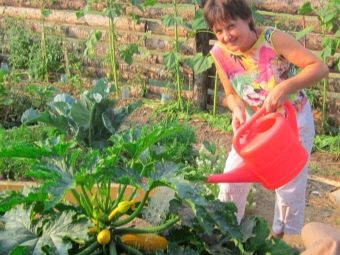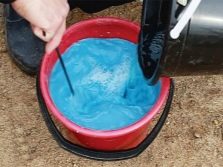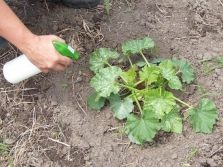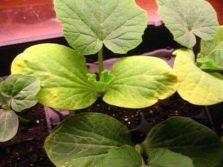Why do zucchini turn yellow and how to deal with it?
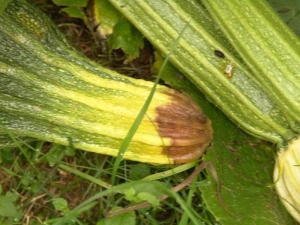
Squashes are very loved by the people of our country. This product is used in many dishes and helps out throughout the year.However, during cultivation, many gardeners are faced with one common problem that can do great harm to a crop - changing the color of the leaves to yellow. In this case, you must immediately begin to correct the situation.
The reasons
When the zucchini leaves turn yellow, it means that something is not normal with the plant. Ideally, the leaves should be a bright green saturated color, rather large and strong. This appearance is a guarantee that the ovary will soon appear, and then the fruit. If the color suddenly began to go to yellowness, which, by the way, can occur even at the seedling stage, it is important to immediately determine the cause of this phenomenon. We should start with the fact that vegetables very poorly tolerate a drop in ambient temperature. Therefore, any cooling leads to the fact that the plant begins to weaken, and the foliage - to turn yellow. Based on this, we can conclude that the appearance of zucchini in the open field should not occur before summer. If we are talking about a greenhouse, the landing can be made in early May.
Yellowness may be the result of improper planning of the garden. Zucchini loves well-lit areas, but if it stays in the sun for too long, the leaves immediately dry and turn yellow. Therefore, it is possible to plant a crop only on a bed that will be exposed to direct sunlight for no more than four or five hours (at that, the light day must be at least twelve hours). Additionally, you can construct a canopy that will prevent the burning of the plant, and put it at noon. Leaflets can turn yellow in the case of too thick plantings. If the seedlings were initially planted without observing the required intervals, then the growing bushes will lack air and space. This is especially true of the bottom sheets that have problems with ventilation. As a result, the foliage will turn yellow, and then, if it is not removed, it also rots.
Wrong watering
Poor watering system also contributes to the appearance of yellowed foliage. This happens because the land is irrigated at noon, that is, at the wrong time. The combination of moisture from irrigation and bright sunlight causes thermal burns and the appearance of spots on the zucchini leaves. That is why the watering of culture can be carried out only in the morning or evening hours.
Water should be settled and comfortable temperature. It is important to prevent liquid from entering the green parts of the plant and inflorescences, and that the bushes are not flooded with water. It should be borne in mind that sometimes the leaves begin to dry out and because of the small amount of moisture in the soil. Therefore, you need to water regularly, and the need for liquid to determine the state of the top layer of soil. It is very important that no cracks on the surface or moisture stagnation occur. Incorrect “water relationships” can also lead to yellowing of the fruit itself. Excessive moisture causes squash to rot and then change color. Therefore, during this care procedure, it is important to control the fullness of the upper layer of fluid to avoid excessive moisture.
By the way, the fruits may turn yellow even when they are not picked in time. If they are laid on the bed, then their density will deteriorate, and the traditional shade will change to a pale yellow. Such fruits quickly lose juiciness, their skin becomes coarse, and the seeds become too large.
Diseases and pests
Of course, a sudden change in shade can also signal diseases that have arisen. First of all, it is downy powdery mildew. This fungus is rapidly developing and affects not only zucchini, but also tomatoes and other vegetables. It will be determined by the state of the leaves — on the inside, and then on the outside, oily specks of a light yellow color are found. First, they are small, and then rapidly increase. The very same sheet at this time dries.Usually, the disease develops with an abundance of precipitation on those cultures that are not properly cared for. If time does not take action, then all landing will be destroyed. With powdery mildew, all infected bushes should be immediately cleaned, and the soil should be dug up every autumn.
The appearance of anthracnose is also possible, most often when grown in a greenhouse. First, on the leaves appear slurred forms of spots, which then become dirty yellow, like a bush was burned by sunlight. After that, the leaves dry up, and the disease gets to the zucchini themselves. They also turn yellow, and then the process of decay begins. Culture also begins to change color when chlorosis is affected, which is a consequence of the lack of sufficient loosening of the earth. Air does not reach the root system, the whole plant is weakened, and the leaves become yellow.
Among the pests most often this culture is attacked by a spider mite. From the seamy side a thin cobweb appears on the sheets, the pest itself settles in it. After this, the leaf becomes stained, turns yellow and finally falls.
Nutrient Shortage
Another common cause of yellowing foliage is the lack of beneficial elements in the soil. First, the lower leaves turn yellow, and then the problem spreads throughout the bush. And the sheet changes color first along the edges, and then it deforms and falls. This situation occurs when there is a shortage of nitrogen or moisture in the soil, as a result of which the transportation of beneficial elements is hampered and the chlorophyll content decreases. Everything leads to the fact that the sun burns the foliage, which turns yellow, and then dries. In this case, you need to make nitrogen fertilizers, sold in specialty stores.
In addition, it is important to normalize the condition of the soil - zucchini can not grow on too sour soil. The leaves will quickly turn yellow, and the bushes will wither. This issue will have to be resolved even before the stage of planting of seedlings - it will be necessary to add lime, as well as humus with ash. In general, the ground for squash should be nutritious. A suitable mixture is purchased in the store or combined with your own hands from peat, river sand and turf. All components must be taken in the same proportions and mix. It is recommended to fertilize sprouts regularly with mineral fertilizers.
What can be processed?
If powdery mildew became the reason for the appearance of yellow color, then the following should be done: several times to spray bushes with copper chloroxide and bordeaux liquid. In addition, at the stage of preparing seeds, they should be soaked in warm water for prophylaxis. Do not forget about the regular airing. To relieve zucchini from yellowing due to anthracnosis, you can eliminate the damaged bushes and spray them with Bordeaux mixture or colloidal sulfur. Do not forget about prevention - the elimination of residues in the soil and greenhouse processing.
The fight against spider mites can be carried out in several ways. First, 200 grams of soap are rubbed on a grater. They are mixed with a kilogram of wood ash and diluted in 10 liters of water. Treatment with this solution is carried out every two days until the pest completely disappears. Secondly, you can use the tops of potatoes in the case when it has not undergone phytophthora disease. Greens are cut into small pieces and filled with water, completely covering the green mass. It is necessary to insist during the week or 10 days, and the cover should be closed. This tool can be used every day. Thirdly, pharmacy chamomile and a few other ingredients will come to the rescue. A kilogram of wood ash and four garlic heads are poured with 10 liters of chamomile decoction, which will require 200 grams of dry powder.
This solution is infused for a week, it will have to be stirred regularly.Then it is necessary to process courgettes three times, which should fit in a weekly gap. It is believed that this method is the most effective.
Useful Care Tips
In the case when the leaves are still yellow in the seedlings, you should check whether the entire leaf plate is damaged. If yes, then the sprout will have to throw out, but if not - then the situation can still be corrected. In young zucchini such a problem usually occurs because of a lack of nitrogen in the soil. Therefore, be sure to buy fertile soil and periodically apply fertilizer. Feeding should begin somewhere in two weeks after the emergence of sprouts. Do not forget about regular spraying of the earth from the spray. Sometimes even a transfer to a container with a large diameter can solve the problem.
It is important to monitor the volume of watering to prevent excessive moisture. After prolonged rains, it would be good to inspect the plant for unpleasant consequences. Pests can be repelled, periodically sprinkling planting grass infusions, which include chamomile, tops of potatoes and nettles. It is useful to process courgettes with solutions of copper sulfate, boric acid, urea with the addition of potassium permanganate.
Weeding beds will have to be timely, not letting the weeds deplete the soil. Mulch holes can be sawdust or dry straw. The procedure can be carried out every two weeks until the ovary begins to form.
As soon as closer to the fall, all the leaves begin to change color and dry out, this may indicate that it is time to harvest. The procedure should be completed tidy tops on the site.
Yellowed sheets must be immediately removed - removed from the bushes and even burned. This greens can not be used for compost or other needs, and it is better not to leave the garden. When the damaged parts are eliminated, you can begin processing the bushes. The tool itself is prepared immediately before the procedure. It is better to spray in the morning, until a bright sun appears in the sky, and in those days when the wind is not too strong. If damaged young shoots and adult bushes are grown in the same greenhouse, then all the plants need to be processed at the same time.
What to do if zucchini begin to turn yellow and rot, see the next video.




